4.07.2020
SpaceX Crew Dragon spacecraft caught on camera during NASA astronaut spacewalk

SpaceX’s first astronaut-proven Crew Dragon spacecraft has been caught on camera by one of the two NASA astronauts that piloted it during a routine spacewalk to repair the orbital International Space Station (ISS).
While outside the station to replace aging lithium ion batteries tasked with storing solar energy and powering the ISS during orbital night, NASA astronaut Bob Behnken was also able to take photos. Documenting the complex task that must be done during extravehicular activities (EVAs/spacewalks) is a routine and crucial part of ensuring that things go according to plan and knowing what went wrong when they don’t.
As an excellent side effect of that important work, some of those same photos can be less technical and more whimsical, capturing spectacular views of the orbital outpost. For the current crew, the location of the batteries that needed to be replaced luckily coincided with the location of most US docking and berthing ports, creating an opportunity for the two NASA astronauts to capture photos of the newest addition to the space station.

SpaceX’s historic Crew Dragon spacecraft has now spent more than a month in orbit since its May 30th astronaut launch debut and May 31st space station arrival. Crew Dragon is the seventh US spacecraft ever to launch astronauts into orbit in more than half a century of human spaceflight, making NASA’s photos of the vehicle all the more significant.
While decidedly less significant, as of July 3rd, Crew Dragon capsule C206 is also just 5-6 days away from breaking SpaceX’s record for a longest-duration orbital spaceflight – currently held by Cargo Dragon C111 and C112 after ~39.5 days spent in orbit.
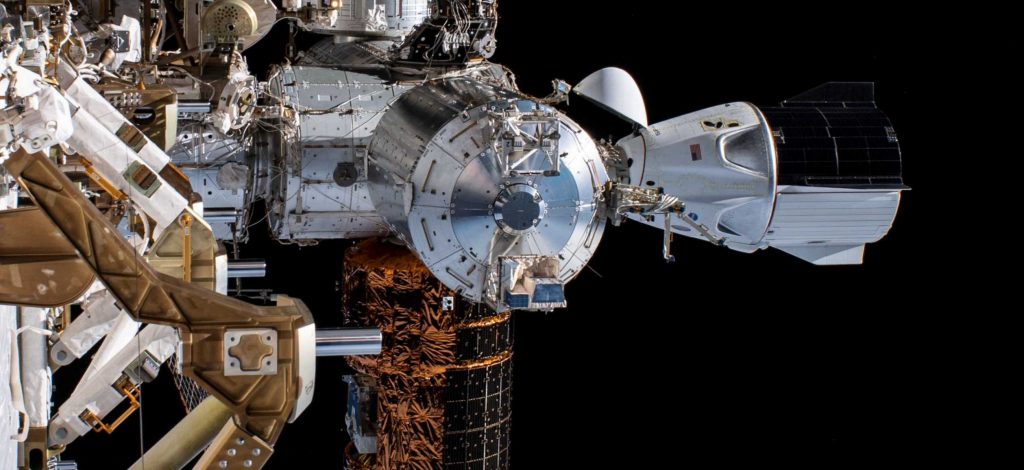
Short of a major emergency, the Demo-2 Crew Dragon is all but guaranteed to smash that record. According to current plans, the spacecraft is scheduled to attempt the second, equally critical half of its demonstration mission – safely returning NASA astronauts Bob Behnken and Doug Hurley to Earth – no earlier than (NET) August 2nd. NASA has to balance its competing needs for Crew Dragon to complete its Demo-2 mission sooner than later and the completion of several critical maintenance tasks (several involving spacewalks like the one on July 1st) while the space agency has a full crew compliment aboard the ISS.
When Behnken and Hurley depart the ISS in August, NASA will have just one crew member – Chris Cassidy – aboard the station until SpaceX and the space agency are ready for their second Crew Dragon astronaut mission. Known as Post Certification Mission 1 (PCM-1) or Crew-1, a brand new Crew Dragon is scheduled to launch four astronauts – three NASA and one JAXA (Japan’s space agency) – no sooner than six weeks after Demo-2 successfully splashes down. If things don’t go perfectly during Crew Dragon’s first crewed reentry, descent, and landing, that gap will grow significantly.
Either way, it’s likely that Crew Dragon C206 will spend at least 60-70 days in orbit before SpaceX and NASA attempt to return Behnken and Hurley to Earth. For now, the historic Dragon spacecraft will get to enjoy at least a few more weeks at the International Space Station.
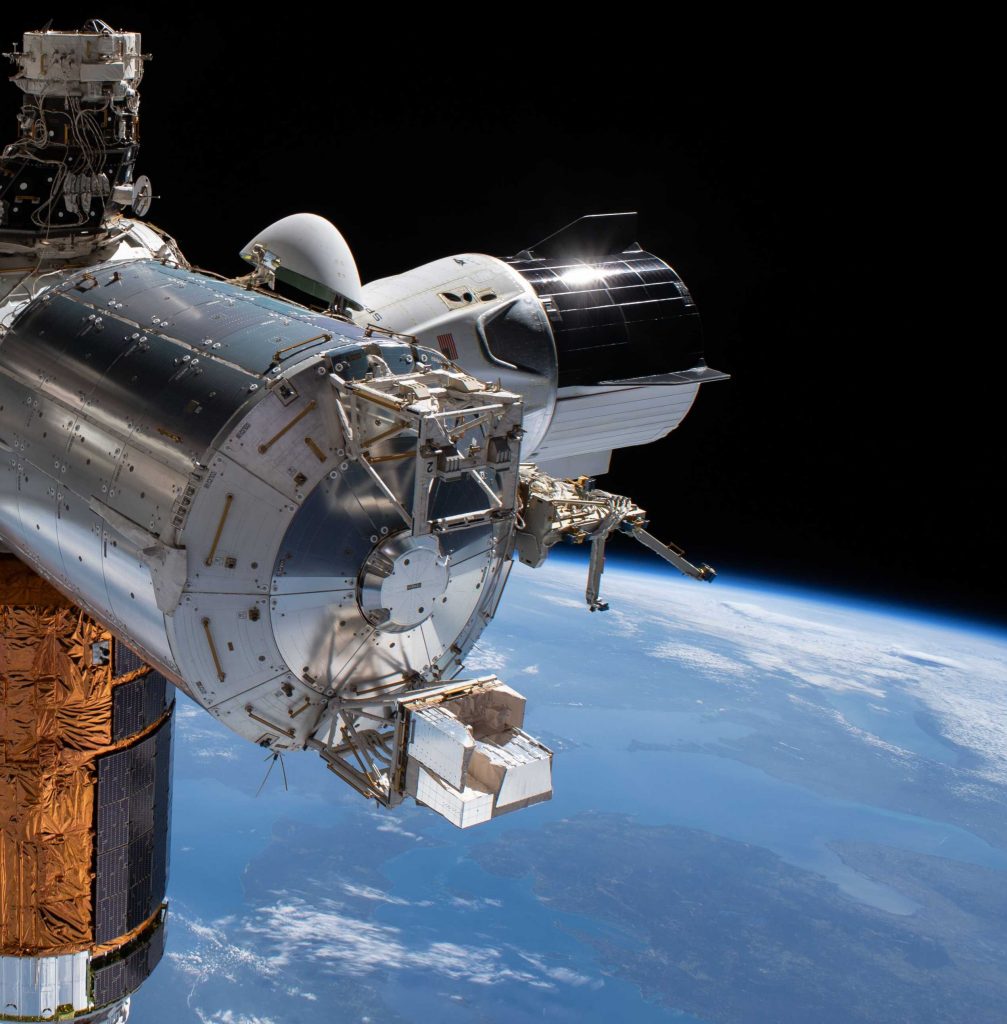
Quelle: TESLARATI
----
Update: 26.07.2020
.
NASA to Provide Coverage of Astronauts’ Return from Space Station on SpaceX Commercial Crew Test Flight
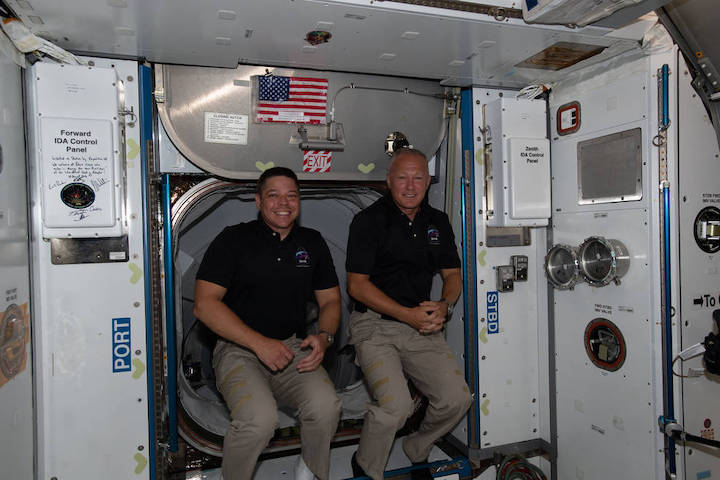
NASA will provide live coverage of activities leading up to, during, and following the return of the agency’s SpaceX Demo-2 test flight with the agency’s astronauts Robert Behnken and Douglas Hurley from the International Space Station.
The duo arrived at the orbiting laboratory on May 31, following a successful launch on May 30 on a SpaceX Falcon 9 rocket from NASA’s Kennedy Space Center in Florida.
NASA and SpaceX are targeting 7:34 p.m. EDT Saturday, Aug. 1, for undocking of the Dragon “Endeavour” spacecraft from the space station and 2:42 p.m. Sunday, Aug. 2, for splashdown, which will be the first return of a commercially built and operated American spacecraft carrying astronauts from the space station.
Coverage on NASA TV and the agency’s website will begin at 9:10 a.m., Aug. 1, with a short farewell ceremony on station and resume at 5:15 p.m., with departure preparations through splashdown and recovery at one of seven targeted water landing zones in the Atlantic Ocean or Gulf of Mexico off the coast of Florida.
All media participation in news conferences and interviews will be remote; no media will be accommodated at any NASA site due to the ongoing COVID-19 pandemic. To participate in the briefings by phone or to request a remote interview with the crew members, reporters must contact the newsroom at NASA’s Johnson Space Center in Houston at 281-483-5111 no later than two hours prior to each event.
NASA’s SpaceX Demo-2 return coverage is as follows (all times Eastern):
Wednesday, July 29
- Approximately 6 p.m. (or one hour after Return Flight Readiness Review completion) – Return Flight Readiness Review briefing at Johnson, with the following participants:
- NASA Administrator Jim Bridenstine
- Steve Stich, manager, NASA’s Commercial Crew Program
- Joel Montalbano, manager, NASA’s International Space Station Program
- Benji Reed, director, crew mission management, SpaceX
A media phone bridge will be available for this event.
Friday, July 31
- 10:45 a.m. – Crew News Conference from the International Space Station, with the following participants:
- NASA astronaut Bob Behnken
- NASA astronaut Doug Hurley
- NASA astronaut Chris Cassidy
A media phone bridge will be available for this event.
Saturday, Aug. 1
· 9:10 a.m. – SpaceX Dragon Demo-2 Farewell Ceremony aboard the International Space Station (ceremony begins about 9:15 a.m.)
· 5:15 p.m. – NASA TV undocking coverage begins for the 7:34 p.m. undocking (NASA Television will have continuous coverage from undocking to splashdown)
Sunday, Aug. 2
- 2:42 p.m. – Splashdown
- 5 p.m. – Administrator post-splashdown news conference at Johnson, with the following representatives:
- NASA Administrator Jim Bridenstine
- Commercial Crew Program representative
- International Space Station representative
- SpaceX representative
- NASA Astronaut Office representative
A media phone bridge will be available for this event.
Tuesday, Aug. 4
- 4:30 p.m. – Demo-2 Crew News Conference from the Johnson Space Center, with the following participants:
- NASA astronaut Bob Behnken
- NASA astronaut Doug Hurley
A media phone bridge will be available for this event.
These activities are a part of NASA’s Commercial Crew Program, which has been working with the U.S. aerospace industry to launch astronauts on American rockets and spacecraft from American soil to the International Space Station for the first time since 2011. This is SpaceX’s final test flight and is providing data on the performance of the Falcon 9 rocket, Crew Dragon spacecraft and ground systems, as well as in-orbit, docking, splashdown and recovery operations.
The test flight also is helping NASA certify SpaceX’s crew transportation system for regular flights carrying astronauts to and from the space station. SpaceX is readying the hardware for the first rotational mission, which would occur following NASA certification.
The goal of NASA’s Commercial Crew Program is safe, reliable and cost-effective transportation to and from the International Space Station. This could allow for additional research time and increase the opportunity for discovery aboard humanity’s testbed for exploration, including helping us prepare for human exploration of the Moon and Mars.
Quelle: NASA
----
Update: 29.07.2020
.
NASA, SpaceX preparing to bring Crew Dragon home this week
So far, this test flight has been a great success.
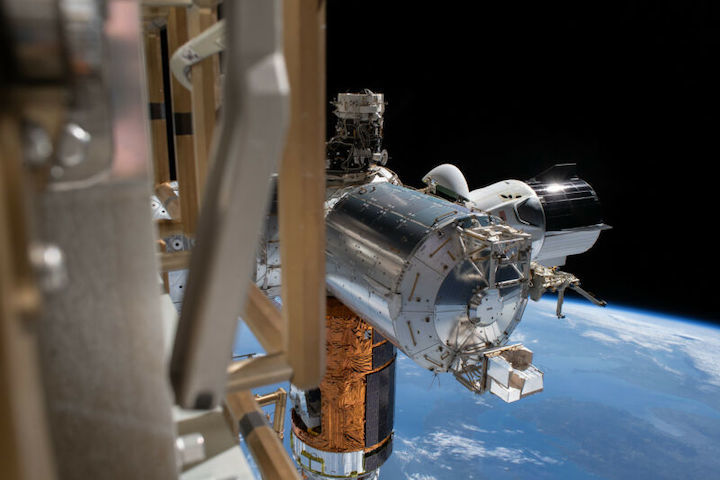
SpaceX's Crew Dragon (center right), the Japanese HTV resupply ship (center bottom), and Europe's Columbus laboratory module appear in this photo taken during a spacewalk conducted by Bob Behnken and Chris Cassidy.
Nearly two months have passed since a Crew Dragon spacecraft carrying two astronauts blasted off the face of the Earth and delivered NASA astronauts Doug Hurley and Bob Behnken into orbit. Now, it's time to come home.
So far, this test flight of the SpaceX-built crew spacecraft has gone nearly flawlessly since its May 30 launch. Named Endeavour by its crew, the spaceship flew smoothly on its way to the International Space Station, where it docked without incident. During the last two months, its solar panels have held up well. And while on orbit, Hurley and Behnken—who performed four spacewalks to help install new batteries outside the station—contributed to NASA's mission.
Now, NASA would like the crew to come home and complete the final, key objective of the test flight, splashing down safely in the ocean. Nominally, this is scheduled for the afternoon of Sunday, August 2.
A final target date and time will be selected on Wednesday, during a "Return Flight Readiness Review," which will consider both the health of the spacecraft and weather. There are seven potential splashdown zones for Dragon around the state of Florida, in both the Gulf of Mexico and Atlantic Ocean. Among the criteria for weather are winds less than 16.5km/hour, calm seas, and a low probability of rainfall.
A decision on where to splash down will come about six hours before undocking, but a final call on whether to actually undock may not be made until the final minutes before departure. Depending on the splashdown location chosen, it will take between six and 30 hours for the crew to return to Earth after undocking.
Crew Dragon will perform two very short burns to separate from the station, and then there will be four slightly longer burns to move Endeavour farther away and begin the journey home. During this time, NASA and SpaceX will continue to monitor weather in the splashdown location, and if conditions deteriorate a decision will be made to wait 24 to 48 hours for another landing attempt.
When a final decision is made to commit to a landing, the Dragon capsule will shed its trunk and perform a deorbit burn. During the reentry process Dragon will be subjected to temperatures as high as 1,950°C, relying on its forward heat shield to absorb these extreme conditions.
Once in the lower atmosphere, the capsule's drogue parachute will deploy at about 5.5km above the planet's surface, followed by the main parachutes at an altitude of about 2km. After splashing down, Hurley and Benhken will remain inside Dragon for 30 to 60 minutes, depending on sea states, before either the Go Searcher and the Go Navigator recovery ship hoists the spacecraft onto its main deck.
After an initial checkout on the ship, in most scenarios, the crew will board a helicopter to fly to Cape Canaveral. On land, they will take a NASA plane that will bring them to Ellington Field, near their homes in Houston. And then, finally, they will be done flying for a while.
Quelle: arsTechnica
----
Update: 30.07.2020
.
Splashdown of NASA astronauts off the coast of Florida in less than a week
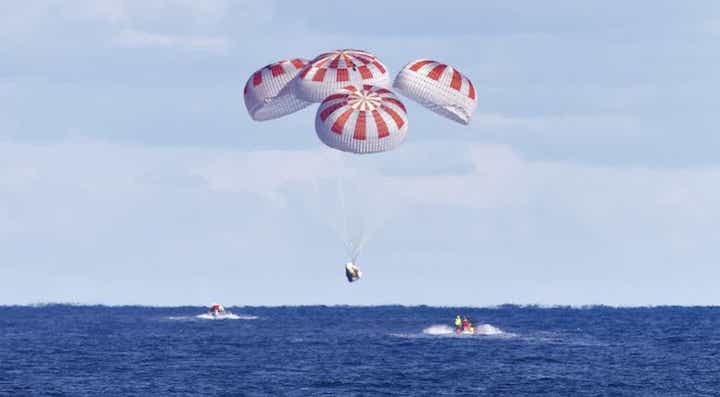
What goes up must come down — in this case it will be astronauts Bob Behnken and Doug Hurley yielding to the laws of gravity as they return to Earth in the SpaceX Dragon spacecraft and splashdown in the ocean — a feat that hasn’t been done in 45 years since the last Apollo mission in 1975.
The capsule, named Endeavor, plans to undock from the International Space Station on Saturday, August 1 at 7:34 p.m. EDT and will come splashing down on Sunday, August 2 at 2:42 p.m. EDT.
Endeavor, which launched to space aboard a SpaceX Falcon 9 rocket at the end of May, will splashdown at one of seven possible landing sites around the state of Florida. The potential locations are off the coasts of Pensacola, Panama City, Tallahassee, Tampa, Jacksonville, Daytona and Cape Canaveral.
Unfortunately, the landing won't be visible from land. Depending on the location chosen, the landing site will be 22 to 175 nautical miles off shore.
The world hasn’t seen an ocean landing of a spacecraft since the Apollo era in the 1970s. The last one was the joint American and Russian venture in 1975 when an Apollo module docked with a Soyuz capsule. That mission came to an end when the American astronauts landed in the Pacific Ocean off the coast of Hawaii on July 21, 1975.
NASA and SpaceX are deep into planning the historic splashdown of NASA astronauts in a commercial spacecraft off the coast of Florida.
About two days prior to the departure, NASA and SpaceX will choose a primary and alternative landing sites. As expected, the weather and oceanic conditions will determine the landing location. Dodging Florida’s famous summer storms will be part of the challenge.
Teams also prioritize locations that require the shortest amount of time between undocking and splashdown and that can occur during daylight.
NASA and SpaceX won't decide on the primary splashdown target until six hours before undocking.
More: SpaceX Crew Dragon capsule successfully docks at ISS with astronauts
More: SpaceX and NASA make history with launch of astronauts from Kennedy Space Center
After undocking, if weather conditions deteriorate, the spacecraft can “wave-off” the landing opportunity and stay in orbit for another 24 to 48 hours until another location is determined.
The actual landing is just as dangerous as launch if not more. The capsule will be traveling at 17,500 miles an hour prior to re-entry and can reach 3,500 degrees Fahrenheit as it barrels through Earth’s atmosphere. Mission control won’t be able to communicate with the astronauts for an agonizing six minutes during the re-entry blackout period.
Once the astronauts have safely landed, they will be picked-up by a SpaceX recovery ship (either Go Searcher or Go Navigator) staffed with spacecraft engineers, water recovery specialists, medical professionals, NASA cargo experts and others to assist in the recovery.
Quelle: Florida Today
----
Update: 31.07.2020
.
NASA Astronauts in Space to Discuss Upcoming SpaceX Crew Dragon Return

NASA astronauts Robert Behnken and Douglas Hurley will address their upcoming SpaceX Crew Dragon departure and splashdown in a news conference at 10:45 a.m. EDT Friday, July 31, from the International Space Station.
Fellow NASA astronaut and current Expedition 63 commander Chris Cassidy will join the agency’s SpaceX Demo-2 test flight crew for the 30-minute news conference, which will air live on NASA Television and the agency’s website just two days before Behnken and Hurley are targeted to return to Earth.
All media participation will be remote; no media will be accommodated at any NASA site due to the COVID-19 pandemic. Media may ask questions by phone by calling the newsroom at NASA’s Johnson Space Center in Houston at 281-483-5111 no later than 8:45 a.m. EDT (7:45 a.m. CDT) Friday, July 31.
Weather permitting, NASA and SpaceX are targeting 2:42 p.m. EDT Sunday, Aug. 2, for the splashdown and conclusion of the Demo-2 test flight mission, which is part of NASA’s Commercial Crew Program. The SpaceX Crew Dragon spacecraft, named Endeavour, lifted off May 30 on the company’s Falcon 9 rocket from Launch Complex 39A at NASA’s Kennedy Space Center in Florida.
With this test flight, NASA and the U.S. aerospace industry are marking the first successful launch of a crew to the space station on a commercially built and operated American rocket and spacecraft, and a safe return to Earth for that spacecraft and crew.
This is SpaceX’s final test flight in NASA’s Commercial Crew Program and will provide data on the performance of the Falcon 9 rocket, Crew Dragon spacecraft, and ground systems, as well as in-orbit, docking, landing, and crew return operations.
Quelle: NASA
----
Update: 2.08.2020
.
Astronauts Set To Return To Earth In First U.S. Splashdown In Decades
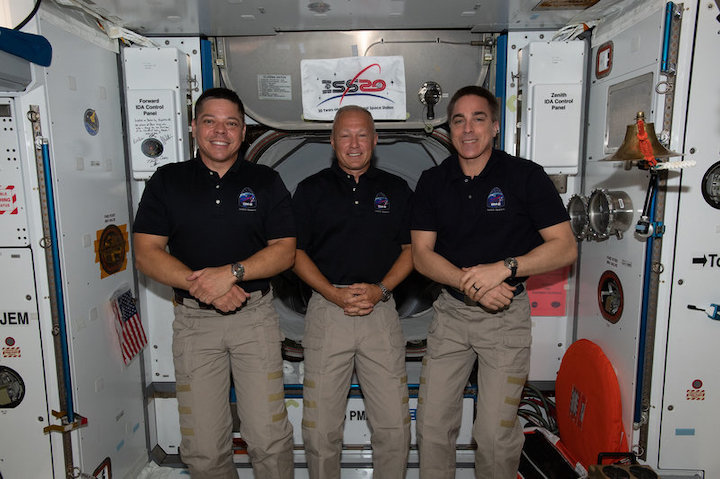
NASA astronauts (from left) Bob Behnken, Doug Hurley and Chris Cassidy are the U.S. members of the Expedition 63 crew aboard the International Space Station. Behnken and Hurley are scheduled to return to Earth on Aug. 2.
The two astronauts that blasted off in the first private space vehicle to take people to the International Space Station are about to return to Earth — by splashing down in the waters around Florida.
This will be the first planned splashdown for space travelers since 1975, although a Russian Soyuz capsule did have to do an emergency lake landing in 1976.
NASA astronaut Douglas Hurley says that he and his crewmate Robert Behnken are prepared for the possibility of seasickness.
"Just like on an airliner, there are bags if you need them. And we'll have those handy," Hurley said in a press conference held on Friday, while on board the station. "And if that needs to happen, it certainly wouldn't be the first time that that's happened in a space vehicle. It will be the first time in this particular vehicle, if we do."
The astronauts will come home in the same SpaceX Dragon capsule that took them up on May 30. Their flight marked the first time people had been launched to orbit from U. S. soil since NASA retired its space shuttles in 2011.
The success of their trip in the SpaceX vehicle has been a major milestone for commercial space travel, and a vindication of NASA's long-term plan to rely on space taxis for routine flights to and from the orbiting outpost—while the government agency focuses on developing vehicles for a return to the moon.
The current plan is for the Dragon "Endeavour" capsule to undock from the International Space Station on Saturday at 7:34 p.m. ET, with scheduled splashdown at 2:42 p.m. ET on Sunday. There are potential splashdown zones both in the Atlantic and the Gulf of Mexico. With a hurricane headed towards Florida, however, it's unclear if the weather will cooperate with the plan.
"We have confidence that the teams on the ground are, of course, watching that much more closely than we are," said Behnken. "And we won't leave the space station without some good landing opportunities in front of us, good splashdown weather in front of us."
He said the astronauts could always stay on the space station longer. "There's more chow and I know the space station program's got more work that we can do," said Behnken.
After the astronauts undock from the station, they can remain in the capsule for 24 to 48 hours before splashing down.
Their mission is technically a demonstration flight—it is the final test for SpaceX's crew system to be certified by NASA as 'operational' for future astronaut missions to and from the space station.
Already, NASA has assigned astronauts to future SpaceX Crew Dragon flights—including Megan McArthur, who happens to be married to Behnken.
"She's super excited to be assigned to a SpaceX mission," says Behnken, who says the thing about his return to Earth that he's looking forward to the most is seeing his wife and son.
"My son is six years old," says Behnken, "and I can tell from the videos that I get, and talking to him on the phone, that he's changed a lot even in just the couple of months that we've been up here."
Quelle: npr
